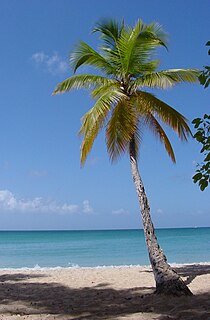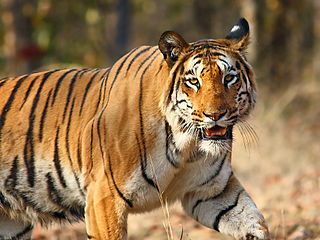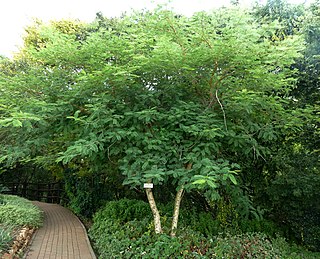
The Arecaceae is a family of perennial flowering plants in the monocot order Arecales. Their growth form can be climbers, shrubs, tree-like and stemless plants, all commonly known as palms. Those having a tree-like form are called palm trees. Currently 181 genera with around 2,600 species are known, most of them restricted to tropical and subtropical climates. Most palms are distinguished by their large, compound, evergreen leaves, known as fronds, arranged at the top of an unbranched stem. However, palms exhibit an enormous diversity in physical characteristics and inhabit nearly every type of habitat within their range, from rainforests to deserts.

Teak is a tropical hardwood tree species in the family Lamiaceae. It is a large, deciduous tree that occurs in mixed hardwood forests. Tectona grandis has small, fragrant white flowers arranged in dense clusters (panicles) at the end of the branches. These flowers contain both types of reproductive organs. The large, papery leaves of teak trees are often hairy on the lower surface. Teak wood has a leather-like smell when it is freshly milled and is particularly valued for its durability and water resistance. The wood is used for boat building, exterior construction, veneer, furniture, carving, turnings, and other small wood projects.

Senegalia greggii, formerly known as Acacia greggii, is a species of tree in the genus Senegalia native to the southwestern United States and northern Mexico, from the extreme south of Utah south through southern Nevada, southeast California, Arizona, New Mexico and western Texas to Baja California, Sinaloa and Nuevo León in Mexico. The population in Utah at 37°10' N is the northernmost naturally occurring Senegalia species anywhere in the world.

Catechu is an extract of acacia trees used variously as a food additive, astringent, tannin, and dye. It is extracted from several species of Acacia, but especially Senegalia catechu, by boiling the wood in water and evaporating the resulting brew. It is also known as cutch, black cutch, cachou, cashoo, terra Japonica, or Japan earth, and also katha in Hindi, kaath in Marathi, khoyer in Assamese and Bengali, and kachu in Malay.

Senegalia senegal is a small thorny deciduous tree from the genus Senegalia, which is known by several common names, including gum acacia, gum arabic tree, Sudan gum and Sudan gum arabic. In parts of India, it is known as Kher or Khor. It is native to semi-desert regions of Sub-Saharan Africa, as well as Oman, Pakistan, west coastal India. It grows to a height of 5–12 metres (16-40'), with a trunk up to 30 cm (1') in diameter. Sudan is the source of the world's highest quality gum arabic, known locally as hashab gum in contrast to the related, but inferior, gum arabic from Red acacia or talah gum.

Diospyros melanoxylon, the Coromandel ebony or East Indian ebony, is a species of flowering tree in the family Ebenaceae native to India and Sri Lanka; it has a hard, dry bark. Its common name derives from Coromandel, the coast of southeastern India. Locally it is known as temburini or by its Hindi name tendu. In Odisha, Jharkhand, and Assam, it is known as kendu. The leaves can be wrapped around tobacco to create the Indian beedi, which has outsold conventional cigarettes in India. The olive-green fruit of the tree is edible

|thumb]]
Chaudhary Lal Singh is an Indian politician and a member of the 12th Legislative Assembly of Jammu and Kashmir. He was Minister for Forest, Environment, Ecology of J&K in PDP-BJP coalition government in J&K. He represents the Basohli constituency in Jammu and Kashmir Assembly and is president of the Dogra Swabhimaan Sangathan.

Vachellia nilotica is a flowering plant tree in the family Fabaceae. It is native to Africa, the Middle East and the Indian subcontinent. It is also a Weed of National Significance in Australia as well as a Federal Noxious Weed in the United States.

Senegalia catechu is a deciduous, thorny tree which grows up to 15 m (50 ft) in height. The plant is called khair in Hindi, and kachu in Malay, hence the name was Latinized to "catechu" in Linnaean taxonomy, as the type-species from which the extracts cutch and catechu are derived. Common names for it include kher, catechu, cachou, cutchtree, black cutch, and black catechu.

Vachellia horrida is a low spreading shrub or sometimes tree native to both the wet and dry scrublands of tropical to subtropical East Africa. Common names for it are Cape gum and dev-babul. It is also found elsewhere in Africa, Asia, India and South America. It frequently has stipular spines 9.5 cm long. V. horrida is an important browse plant in the tropics, particularly during the dry season.

Senegalia polyacantha, also known as white thorn, is a flowering tree which can grow up to 25m tall. Polyacantha has the meaning "many thorns" in Latin. The tree is native to Africa, India, the Indian Ocean and Asia, but it has also been introduced to the Caribbean.

Vachellia sieberiana, until recently known as Acacia sieberiana and commonly known as the paperbark thorn or paperbark acacia, is a tree native to southern Africa and introduced into Pakistan. It is used in many areas for various purposes. The tree varies from 3 to 25 m in height, with a trunk diameter of 0.6 to 1.8 m. It is not listed as being a threatened species.

Senegalia mellifera is a common thorn tree in Africa. The name mellifera refers to its sweet-smelling blossoms and honey. Its lumber turns pitch black when oiled. Common names of the tree include Blackthorn and Swarthaak (Afrikaans). It is listed as being not threatened.

Senegalia polyacantha subsp. campylacantha is a perennial tree native to Africa. Common names for it are whitethorn and witdoring. It is not listed as being a threatened species. Its uses include wood and medicine.

The state of Karnataka in South India has a rich diversity of flora and fauna. It has a recorded forest area of 38720 km2 which constitutes 12.3467719% of the total geographical area of the state. These forests support 25% of the elephant population and 20% of the tiger population of India. Many regions of Karnataka are still unexplored and new species of flora and fauna are still found. The Western Ghats mountains in the western region of Karnataka are a biodiversity hotspot. Two sub-clusters of the Western Ghats, Talacauvery and Kudremukh in Karnataka, are in a tentative list of sites that could be designated as World Heritage Sites by UNESCO. The Bandipur and Nagarahole national parks which fall outside these subclusters were included in the Nilgiri biosphere reserve in 1986, a UNESCO designation. Biligiriranga Hills in Karnataka is a place where Eastern Ghats meets Western Ghats. The state bird and state animal of Karnataka are Indian roller and the Indian elephant respectively. The state tree and state flower are sandalwood and lotus respectively. Karnataka is home to 406+ tigers.

Senegalia is a genus of flowering plants in the family Fabaceae. It belongs to the Mimosoid clade. Until 2005, its species were considered members of Acacia. The genus is still considered polyphyletic and will require further division. Senegalia can be distinguished from other acacias by its spicate inflorescences and non-spinescent stipules.

Senegalia pennata, is a species of plant which is native to South and Southeast Asia. It is a shrub or small tropical tree which grows up to 5 metres (16 ft) in height. Its leaves are bipinnate with linear-oblong and glabrous pinnules. Its yellowish flowers are terminal panicles with globose heads. The pods are thin, flat and long with thick sutures.
Ghatigaon Wildlife Sanctuary is a wildlife sanctuary in India. Ghatigaon covers 511.0 km² in Madhya Pradesh state, west of the city of Gwalior. It extends to Tigra Dam, and includes part of the reservoir.
















